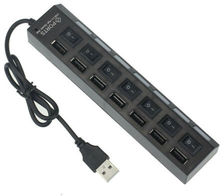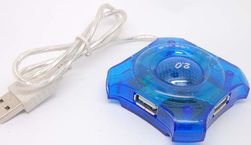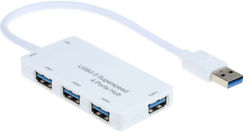
I needed a USB hub, and found that not many stores around me carry them any more. Not in a rush, so hubs from China via Ebay are a good option. The listings are cheap but sound suspicious, so I decided to buy a few and check them out. So here they are. Prices are Ebay “Buy It Now” prices, including shipping for quantity one.

0a05:7211 Unknown Manufacturer hub
0a05:7211 Unknown Manufacturer hub
Construction was somewhat sloppy, with fragments of solder scattered around the board. Interesting design: the current-limiting resistors for the LED's are printed directly onto the board using conductive ink. Considering that surface mount resistors cost well under a penny in modest quantities, it's hard to believe that replacing ordinary nonprecision resistors saves either cost or assembly time.
So it does work, but the marking is —shall we say — optimistic.

0a05:7211 Unknown Manufacturer hub

05e3:0606 Genesys Logic, Inc. USB 2.0 Hub / D-Link DUB-H4 USB 2.0 Hub
lsusb -v describes it as a Full Speed(12Mbps) not High
Speed(480Mbps) device. This is another chip-on-board product, so it's impossible
to know what kind of hub chip is really being used.

lsusb finds
05e3:0610 Genesys Logic, Inc. 4-port hubThere are some even cheaper devices, around the $1.00 or less range. Per a careful reading, they aren't even hubs. They are just a set of USB connectors wired in parallel. Such an adapter might be ok for devices that only need power, but one needs to be sure the upstream power source (PC or wall wart) isn't overloaded.
A good quality HUB hub really should have current limiting protection on each downstream port. None of these units have that. Instead the +5volt input from the upstream USB port is connected directly to all of the downstream USB ports. That's not too much of a problem with simple low power devices like mice and keyboards, but it would be possible to overload the host port by plugging in multiple higher powered devices (such as trying to charge muliple phones at the same time).
Some have a power port, to connect an external +5 power supply. However, the external +5 connector is simply wired in parallel with the +5 power from the USB host port. This is a bad idea: it allows the external supply to pump power back into the host (PC, laptop, or whatever), especially if the host is off when the external supply is on. You might be able to get by with this if the host is well-designed, but personally I would never use an external supply with one of these devices. A couple of them are safe: they don't even have the power jack mounted. They just have a hole in the case and an empty spot on the circuit board.
Data sheets for USB Hub IC's generally recommend protection diodes on the signal lines, to protect from damage due to static. None of these have such diodes, of course. At this price it's not a big deal: just throw the thing away if it gets static-zapped.
Superspeed signal lines require careful control of the trace layout and geometry for good performance. Google “Characteristic Impedance ”, “stripline ”, etc if you are interested in more details. Meeting those specs trypically requires at least a 4-layer circuit board. This USB3 hub uses a 2-layer board to save cost. I can't actually check the impedance because it requires expensive equipment that I don't have, but I would be surprised if it meets spec. If it works it works, but I would watch out for problems in challenging situations (such as longer cables, cheap cables, or multiple hubs in series).
You get what you pay for. They all work, and I think they're well worth what little I paid for them. Just be careful, and don't put too much faith in the descriptions.
If you need good-quality hubs that fully meet the USB specs then, well, good luck. I'm not sure how to separate the ones that are actually good from those that just have a good-sounding description.